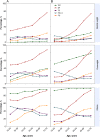Sex, BMI and age differences in metabolic syndrome: the Dutch Lifelines Cohort Study
- PMID: 28420718
- PMCID: PMC5457493
- DOI: 10.1530/EC-17-0011
Sex, BMI and age differences in metabolic syndrome: the Dutch Lifelines Cohort Study
Abstract
Introduction: To evaluate the prevalence of metabolic syndrome (MetS) and its individual components within sex-, body mass index (BMI)- and age combined clusters. In addition, we used the age-adjusted blood pressure thresholds to demonstrate the effect on the prevalence of MetS and elevated blood pressure.
Subjects and methods: Cross-sectional data from 74,531 Western European participants, aged 18-79 years, were used from the Dutch Lifelines Cohort Study. MetS was defined according to the revised NCEP-ATPIII. Age-adjusted blood pressure thresholds were defined as recommended by the eight reports of the Joint National Committee (≥140/90 mmHg for those aged <60 years, and ≥150/90 mmHg for those aged ≥60 years).
Results: 19.2% men and 12.1% women had MetS. MetS prevalence increased with BMI and age. Independent of BMI, abdominal obesity dominated MetS prevalence especially in women, while elevated blood pressure was already highly prevalent among young men. Applying age-adjusted blood pressure thresholds resulted in a 0.2-11.9% prevalence drop in MetS and 6.0-36.3% prevalence drop in elevated blood pressure, within the combined sex, BMI and age clusters.
Conclusions: We observed a gender disparity with age and BMI for the prevalence of MetS and, especially, abdominal obesity and elevated blood pressure. The strict threshold level for elevated blood pressure in the revised NCEP-ATPIII, results in an overestimation of MetS prevalence.
Keywords: BMI; age adjusted; blood pressure; metabolic syndrome; population based; sex.
© 2017 The authors.
Figures


References
-
- Ervin RB. Prevalence of metabolic syndrome among adults 20 years of age and over, by sex, age, race and ethnicity, and body mass index: United States, 2003–2006. National Health Statistics Reports 2009. 131–7. - PubMed
LinkOut - more resources
Full Text Sources
Other Literature Sources

